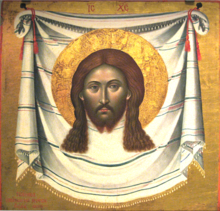Emmanuel Tzanes | |
|---|---|
 | |
| Born | 1610 Rethymno Crete |
| Died | March 28, 1690 Venice |
| Nationality | Greek |
| Movement | Cretan School, Heptanese School |
Emmanuel Tzanes (Greek: Εμμανουήλ Τζάνες; 1610 – 28 March 1690), also known as Bounialis (Greek: Μπουνιαλής) Emmanuel Tzane-Bounialis, Emmanuel Zane, and Emmanuel Tzane, was a Greek Renaissance painter, author, clergyman, and educator. He spent the latter half of his life in Venice, where he was parish priest of the church of San Giorgio dei Greci and a member of the Flanginian School run by the city's Greek Confraternity. Tzanes painted in the style of the Cretan School, influenced by contemporary trends in Venetian painting. His known extant works, over 130 in number, can be found in public foundations, private collections, churches and monasteries in Greece. The most popular of these is The Holy Towel, finished in 1659. Tzanes was a collaborator with Philotheos Skoufos, and brothers with the painter Konstantinos Tzanes and the poet Marinos Tzanes.[1][2][3][4][5]
- ^ Speake, Graham (2021). Emmanuel Tzanes Encyclopedia of Greece and the Hellenic Tradition. London And New York: Rutledge Taylor & Francis Group. p. 443. ISBN 9781135942137.
- ^ Heinz Skrobucha, The World of Icons, 1971, p.97
- ^ Jane Turner, The Dictionary of Art, 1996, p.334
- ^ Steven Bigham, Heroes of the Icon: People, Places, Events, 2000, p.136
- ^ Tsokkoy, Κ. Α. (2008). Aristotle University of Thessaloniki Philosophical School Refugees of the Cretan War (PDF). Thessaloniki, Greece: Aristotle University of Thessaloniki. pp. 87–88.